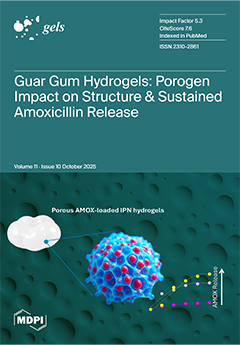The accurate determination of the equilibrium moisture content (EMC) of gel-related powdery samples requires strictly controlled conditions and a long time period. In this study, the adsorption and desorption isotherms of two fructooligosaccharide (FOS) powders and three inulin powders were determined using a dynamic moisture sorption analyzer at 0.1–0.9 water activity (a
w) and 20–35 °C, respectively. The adsorption and desorption isotherms all exhibited type IIa sigmoidal curves; the desorptive isotherm was smooth, the FOS adsorption curves had three inflection points, and the inulin adsorption curves had five inflection points. Large hysteresis between the adsorption and desorption isotherms occurred at 0.1–0.7 a
w for FOS and 0.1–0.6 a
w for inulin. Seven equations, Boquet, Ferro–Fontan, Guggenheim–Anderson–de Boer (GAB), Generalized D’Arcy and Watt (GDW), modified GAB (MGAB), Peleg, and our developed Polynomial, were found to fit the isotherms of the FOS and inulin samples; for adsorption, the best equations were Ferro–Fontan and GDW, and for desorption, the best equations were Polynomial and MGAB. The GDW and MGAB equations could not distinguish the effect of temperature on the isotherms, while the Polynomial equation could. The mean adsorptive monolayer moisture content (
M0) values in FOS and inulin samples were predicted as 7.29% and 7.94% wet basis, respectively. The heat of moisture sorption of FOS and inulin approached that of pure water at about 32.5% and 22.5% wet basis (w.b.) moisture content (MC), respectively. Fourier Transform Infrared Spectroscopy (FTIR) showed that the peaks in inulin with absorbance values above 0.52 and in FOS with absorbance values above 0.35 were at 1020, 1084, and 337 cm
−1; these could represent the amorphous structure (primary alcohol C-OH), C-O group, and hydroxyl functional group, respectively. Microscopic structure analysis showed that inulin powder particles were more round-shaped and adhered together, resulting in hygroscopic and sticky characteristics, with a maximum equilibrium moisture content (EMC) of 34% w.b. In contrast, the FOS powders exhibited irregular amorphous particles and a maximum EMC of 60% w.b. As hydrogels, 3–10% FOS or inulin addition reduced the peak, trough, final, breakdown, and setback viscosities of rice starch pasting, but increased the peak time and pasting temperature. FOS addition gave stronger reduction in the setback viscosity and in amylose retrogradation of rice starch pasting than inulin addition. The differential scanning calorimeter (DSC) showed 3–10% FOS addition reduced the amylopectin aging of retrograded paste of rice starch, but 5–7% inulin addition tended to reduce. These results suggest that FOS and inulin have strong hygroscopic properties and can be used to maintain the freshness of starch-based foods. These data can be used for drying, storage, and functional food design of FOS and inulin products.
Full article






